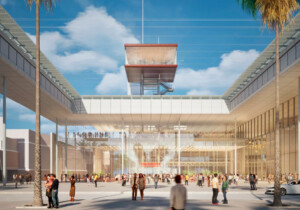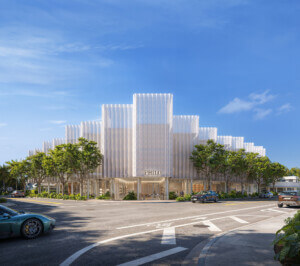This article appears in The Architect’s Newspaper’s April 2017 issue, which takes a deep dive into Florida to coincide with the upcoming AIA Conference on Architecture in Orlando (April 27 to 29). We’re publishing the issue online as the Conference approaches—click here to see the latest articles to be uploaded.
The moon over South Florida looked like a swollen grapefruit in November, its reflection rippling off pools of ocean water that bubbled up through storm drains, crept over seawalls, and swallowed Miami streets. It was a “supermoon,” about 17,000 miles closer to Earth than usual, according to NASA, arriving just in time to supercharge the seasonal high waters known as king tides. The water made an island out of the lifeguards’ shack on Matheson Hammock Park, swept “No Wake” signs from marina harbors onto city streets, and marooned a live octopus in a parking garage along Biscayne Bay.
On days like these, it’s obvious that much of the region now home to about 7 million people began as a network of swampy canals meandering from the Everglades to the ocean. Sometimes nature conspires to remind the city of this fact, as it did in November 2016.
Lately those reminders have become more frequent. The rate of sea-level rise has tripled over the last decade, according to a recent study from the University of Miami, bringing with it more frequent coastal flooding. The U.S. Army Corps of Engineers projects that Miami-Dade County will see about 15 inches of sea-level rise by 2045. And because South Florida sits on porous limestone bedrock, saltwater is not just encroaching on coastal communities, but gurgling up from below.
Right now it’s a nuisance, but over the lifetime of a mortgage, flooding in South Florida could threaten tens of billions of dollars of real estate and upend development in the country’s 10th largest metropolitan area. Architects, planners, and developers are just beginning to overhaul the urban landscape, laying the groundwork for a sweeping transformation of building codes, municipal infrastructure, and design norms that could save the city from rising seas.
The crucial question is: Who will change that built environment? Will it be architects and city officials, safeguarding South Florida against the effects of climate change as the world’s living laboratory for so-called climate resiliency? Or is nature coming to reclaim Miami as a swampland?
Higher Ground
South Florida’s development boom is so lucrative it seems inevitable that it will continue. Before the city was founded in 1896, however, it wasn’t clear that the mouth of the Miami River would ever be anything more than a mosquito-infested trading post—until the industrialist Henry Flagler dragged his railroad south from Palm Beach along the highest ground he could find: a coral ridge between 12 and 25 feet above sea level. The tracks reached Biscayne Bay on April 22, 1896. Three months later Miami was incorporated.
Today, Miami is a bustling, sprawling urban landscape that has been remade to suit cars, but some planners say that the same limestone ridge Flagler used could anchor climate-friendly development.
The Urban Land Institute is drafting a plan for the Arch Creek Basin, a mostly low-lying area straddling 2,800 acres and four municipalities, as well as unincorporated Dade County, around one stretch of the railroad. Primarily poor people of color, the residents of Arch Creek face a severe threat from sea-level rise—one that could eventually force them to abandon the area.
At a charette in November, designers Gustavo Sanchez-Hugalde, Max Zabala and University of Miami professor Sonia Chao presented their idea for a flood-resistant transportation hub at Northeast 125th Street. It would be transit-oriented development, dense with mixed-use buildings and affordable housing, but also with a health clinic, back-up generators and other resources that could come in handy during a disaster.
“Think of these as not just transit but resilience stations,” said Chao.
In the long run, South Florida’s scarcity of higher ground could also make its elevated areas more valuable as waters rise. That could exacerbate gentrification in minority neighborhoods with relatively high elevations like Liberty City and Little Havana.
“It’s a matter of time until investors will head for the higher land,” said James Murley, chief resilience officer for Miami-Dade County. But climate change isn’t forcing people out of their homes just yet. Asked if climate change is a driving force for gentrification in Miami, Murley is skeptical, but others are starting to look toward the future.
“Right now we’re experiencing more of the classic gentrification that comes with a growing real estate economy,” Murley said.
While the mainland mulls long-term plans to adapt to rising seas, the coastal barrier island of Miami Beach is busy building.
Planning for High Water
Over the next five years, the municipality of Miami Beach will spend $400 to $500 million on flood defenses, installing 80 new pumps, raising roads, and strengthening seawalls across the city. So far the city has funded about $200 million of that project by more than doubling stormwater fees.
A law passed last year requires the owners of buildings larger than 7,000 square feet to pay a fee if they don’t get certified as at least LEED Gold. The builders of properties that don’t get LEED certified at all get slapped with a fee equal to 5 percent of their construction costs. That could help raise money for future infrastructure investments.
Miami Beach also requires new buildings to be at least one foot above the base flood elevation of six feet above sea level. As an additional incentive for developers, the city won’t count the raised elevation of a flood-proofed site toward the project’s height limit or floor-to-area ratio.
Miami Beach environment and sustainability director Elizabeth Wheaton said the new requirements wouldn’t stunt development.
“Developers want to build here,” Wheaton said. “They’re going to do what’s required.”
The first building completed under the new elevation requirements is Jean Nouvel’s Monad Terrace, a 59-unit luxury residential tower on the waterfront in South Beach. Nouvel built Monad Terrace’s ground floor more than 11 feet above sea level, elevating all of the building’s interior spaces and its entrance high enough to ward off flooding.
Building high is an increasingly popular choice for private residences, too. The local architect Rene Gonzalez, known for his high-end modernist houses, is building four new homes in the area that are modeled on mangroves—propped up with stilts and columns for an additional layer of privacy that also affords the owner some long-term insurance against flooding. Gonzalez designed his own home on Belle Isle the same way.
“It’s a responsibility that every architect should take on,” said Gonzalez. “Building a house up is not a luxury. It’s a necessity in our current environmental climate.”
For now, however, most of that work is clustered in tony Miami Beach. In Miami-Dade County at large, where nearly half of all residents live in poverty, there are fewer options.
Because saltwater rises up through South Florida’s porous limestone bedrock, it’s not just coastal communities that are at risk. Many of the most threatened areas lie miles inland, in suburban and often low-income areas of Miami-Dade and Broward Counties that can’t afford to elevate all their homes and streets.
“It’s unavoidable that there will be relocations,” said Anthony Abbate, an architect based in Fort Lauderdale in Broward County, just to the north of Miami-Dade. “It’s a difficult conversation but I think we’re on the verge of having it. This has to be a conversation with the people, with the public.”
Miami-Dade is in the middle of a vulnerability analysis for major infrastructure, from its airport to its water system, identifying “adaptation action areas” where city planners might best focus their efforts.
“There’s a lot of work that needs to be done and it needs to be done in short order,” said Abbate.
Some of that work is already underway. The newest addition to the county’s hospital system will pioneer a flood-friendly approach in the recently incorporated town of Doral, just west of Miami International Airport. Designed by Perkins + Will, Jackson West hospital will devote most of its 27 acres to green space and a retention pond to store runoff not just from the built-up part of the site that will house the hospital, but from the developments surrounding the site. Construction is set to begin later this year and the hospital could open in 2020.
Risk and Reward
Perhaps before it faces up to the force of nature, however, South Florida may have to reckon with its runaway real estate market. Wayne Pathman, a land-use attorney and chair of Miami’s Sea Level Rise Committee, said the face of Miami’s climate crisis might not be a natural disaster, but a collapse of the insurance market.
“Flood insurance is going to be the tip of the spear,” Pathman said. “Unlike hurricanes, which are a single event that may not happen for years at a time, sea-level rise is a constant. Once it’s here, it’s here, and it’s never going to get better.”
Pathman said some of his clients with property in Miami Beach and North Beach are already seeing a 500 percent increase in their flood insurance premiums. For now, that’s manageable, he said, because they were probably underpriced in the first place.
“When that jumps as high as $50,000 over the next 10 years, which it will, that’s alarming,” he said.
Areas that today flood two or three times each year could see water in the streets every week, and banks may stop offering mortgages there. That could have ripple effects across the region, Pathman said, jeopardizing tourism dollars and property-tax revenue that Miami-Dade and Broward counties will need to fund new climate-resilient infrastructure.
“Those are our only two industries here in South Florida,” Pathman said. “If we don’t start dealing with the insurance risk, all the ideas we come up with for future infrastructure will be cost-prohibitive because we won’t have any money.”
Reinaldo Borges, an architect who sits on the sea-level rise committee with Pathman, said the luxury houses and museums already built to deal with higher seas show climate-resilient design can provide a return on investment.
“If you design correctly,” he said, “you shouldn’t be worried about insurance risk.”
Borges has a checklist for clients who are looking to invest in the future of Miami real estate—not just flip property for a profit. It includes elevating building mechanical systems, installing hurricane-proof windows, and planning for severe floods.
“For a building like that, all you have to do before a storm is bring your pool chairs inside,” he said.
Climate-proofing one building may be a straightforward design problem. Saving a metro region of 7 million is something else.
Borges came to Miami when he was six years old, brought from Cuba by parents who sought a better life for their children. Today he has two daughters, ages 23 and 29, and he has the same hope for them.
“When you’ve got political leadership in denial, these are challenges I’m concerned about,” said Borges. “This is a world-class city, but people are starting to ask if this is the place they really want to invest.”










